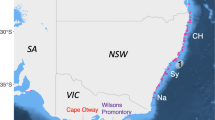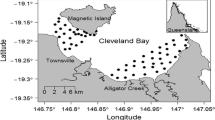Abstract
The demography, spatial distribution, and movement patterns of leopard sharks (Triakis semifasciata) aggregating near the head of a submarine canyon in La Jolla, California, USA, were investigated to resolve the causal explanations for this and similar shark aggregations. All sharks sampled from the aggregation site (n = 140) were sexually mature and 97.1 % were female. Aerial photographs taken during tethered balloon surveys revealed high densities of milling sharks of up to 5470 sharks ha−1. Eight sharks were each tagged with a continuous acoustic transmitter and manually tracked without interruption for up to 48 h. Sharks exhibited strong site-fidelity and were generally confined to a divergence (shadow) zone of low wave energy, which results from wave refraction over the steep bathymetric contours of the submarine canyon. Within this divergence zone, the movements of sharks were strongly localized over the seismically active Rose Canyon Fault. Tracked sharks spent most of their time in shallow water (≤2 m for 71.0 % and ≤10 m for 95.9 % of time), with some dispersing to deeper (max: 53.9 m) and cooler (min: 12.7 °C) water after sunset, subsequently returning by sunrise. These findings suggest multiple functions of this aggregation and that the mechanism controlling its formation, maintenance, and dissolution is complex and rooted in the sharks’ variable response to numerous confounding environmental factors.







Similar content being viewed by others
References
Ackerman LT (1971) Contributions to the biology of the leopard shark, Triakis semifasciata (Girard) in Elkhorn Slough, Monterey Bay, California. MA Thesis. Sacramento State College, California
Battjes JA (1978) Ocean Wave Statistics for 1961 North-Atlantic Storm - Discussion. J Waterw Port Coast Ocean Eng 104:461–462
Bessudo S, Soler GA, Klimley AP, Ketchum JT, Hearn A, Arauz R (2011) Residency of the scalloped hammerhead shark (Sphyrna lewini) at Malpelo Island and evidence of migration to other islands in the Eastern Tropical Pacific. Environ Biol Fish 91:165–176
Booij N, Ris RC, Holthuijsen LH (1999) A third-generation wave model for coastal regions. Model description and validation. J Geophys Res 104:7649–7666
Carlisle AB, Starr RM (2009) Habitat use, residency, and seasonal distribution of female leopard sharks Triakis semifasciata in Elkhorn Slough, California. Mar Ecol Prog Ser 380:213–228
Carlisle A, King A, Cailliet G, Brennan J (2007) Long-term trends in catch composition from elasmobranch derbies in Elkhorn Slough, California. Mar Fish Rev 69:25–45
Carrier JC, Pratt HL, Martin LK (1994) Group reproductive behaviors in free-living nurse sharks, Ginglymostoma cirratum. Copeia 1994:646–656
De Solla SR, Bondurianski R, Brooks RJ (1999) Eliminating autocorrelation reduces biological relevance of home range estimates. J Anim Ecol 68:221–234
Ebert DA, Ebert TB (2005) Reproduction, diet and habitat use of leopard sharks, Triakis semifasciata (Girard), in Humboldt Bay, California, USA. Mar Freshwater Res 56:1089–1098
Economakis AE, Lobel PS (1998) Aggregation behavior of the grey reef shark, Carcharhinus amblyrhychos, at Johnston Atoll, Central Pacific Ocean. Environ Biol Fish 51:129–139
Gorrell L, Raubenheimer B, Elgar S, Guza RT (2011) SWAN predictions of waves observed in shallow water onshore of complex bathymetry. Coast Eng 58:510–516
Grauch VJS, Hudson MR, Minor SA (2001) Aeromagnetic expression of faults that offset basin fill, Albuquerque basin, New Mexico. Geophysics 66:707–720
Grauch VJS, Hudson MR, Minor SA, Caine JS (2006) Sources of along-strike variation in magnetic anomalies related to intrasedimentary faults: a case study from the Rio Grande Rift, USA. Explor Geophys 37:372–378
Gunn PJ (1997) Application of aeromagnetic surveys to sedimentary basin studies. J Aust Geol Geophys 17:133–144
Hearn A, Ketchum J, Klimley AP, Espinoza E, Penaherrera C (2010) Hotspots within hotspots? Hammerhead shark movements around Wolf Island, Galapagos Marine Reserve. Mar Biol 157:1899–1915
Hight BV, Lowe CG (2007) Elevated body temperatures of adult female leopard sharks, Triakis semifasciata, while aggregating in shallow nearshore embayments: Evidence for behavioral thermoregulation? J Exp Mar Biol Ecol 352:114–128
Holden JC (1968) Brackish water ostracods from La Jolla Submarine Canyon 7200 ± 500 years before present. University of California Berkeley Museum of Paleontology, Berkeley, CA
Jacoby DMP, Croft DP, Sims DW (2011) Social behaviour in sharks and rays: analysis, patterns and implications for conservation. Fish Fish. doi:101111/j1467-2979201100436x
Jirik KE, Lowe CG (2012) An elasmobranch maternity ward: female round stingrays urobatis halleri use warm, restored estuarine habitat during gestation. J Fish Biol 80:1227–1245
Judy TC (1987) Reconnaissance geology of Holocene lagoonal deposits in the La Jolla Submarine Canyon and their relationship to the Rose Canyon Fault. Department of Geological Sciences, San Diego State University
Kalmijn AJ (1982) Electric and magnetic field detection in elasmobranch fishes. Science 218:916–918
Klimley AP (1993) Highly directional swimming by scalloped hammerhead sharks, Sphyrna lewini, and subsurface irradiance, temperature, bathymetry, and geomagnetic field. Mar Biol 117:1–22
Klimley AP (2003) The secret life of sharks: a leading marine biologist reveals the mysteries of shark behavior. Simon and Schuster, New York
Klimley AP, Butler SB, Nelson DR, Stull AT (1988) Diel movements of scalloped hammerhead sharks, Sphyrna lewini (Griffith and Smith), to and from a seamount in the Gulf of California. J Fish Biol 33:751–761
Kobayashi BN (1979) California Marine Waters Areas of Special Biological Significance Reconnaissance Survey Report, San Diego-La Jolla Ecological Reserve, San Diego County. Water Quality Monitoring Report No. 79-1
Komar PD (1998) Beach processes and sedimentation. Prentice Hall, Upper Saddle River
Kusher DI, Smith SE, Cailliet GM (1992) Validated age and growth of the leopard shark, Triakis semifasciata, with comments on reproduction. Environ Biol Fish 35:187–203
Le Dantec N, Hogarth LJ, Driscoll NW, Babcock JM, Barnhardt WA, Schwab WC (2010) Tectonic controls on nearshore sediment accumulation and submarine canyon morphology offshore La Jolla, Southern California. Mar Geol 268:115–128
Long JW, Özkan-Haller HT (2005) Offshore controls on nearshore rip currents. J Geophys Res 110:C12007. doi:10.1029/2005JC003018
Lygre A, Krogstad HE (1986) Maximum-entropy estimation of the directional distribution in ocean wave spectra. J Phys Oceanogr 16:2052–2060
Magne R, Belibassakis KA, Herbers THC, Ardhuin F, O’Reilly WC, Rey V (2007) Evolution of surface gravity waves over a submarine canyon. J Geophys Res 112:C01002. doi:10.1029/2005JC003035
Manley J (1995) Diel movement patterns and behaviors of leopard sharks, Triakis semifasciata, at Santa Catalina Island, California. MS Thesis. California State University Long Beach
McGowan JA (1954) Observations on the sexual behavior and spawning of the squid, Loligo opalescens, at La Jolla, California. Calif Fish Game 40:47–54
Moriarty JR (1964) The use of oceanography in the solution of problems in a submarine archaeological site. In: Miller RL (ed) Papers in marine geology. Macmillan, New York
Mull CG, Lowe CG, Young KA (2010) Seasonal reproduction of female round stingrays (Urobatis halleri): steroid hormone profiles and assessing reproductive state. Gen Comp Endocr 166:379–387
Munk WH, Traylor MA (1947) Refraction of ocean waves: a process linking underwater topography to beach erosion. J Geol 55:1–26
Musick JA, Burgess G, Cailliet G, Camhi M, Fordham S (2000) Management of sharks and their relatives (Elasmobranchii). Fisheries 25(3):9–13
Plant NG, Holland KT, Puleo JA (2002) Analysis of the scale of errors in nearshore bathymetric data. Mar Geol 191:71–86
Pondella DJ, Allen LG (2008) The decline and recovery of four predatory fishes from the Southern California Bight. Mar Biol 154:307–313
Pratt HL, Carrier JC (2001) A review of elasmobranch reproductive behavior with a case study on the nurse shark, Ginglymostoma cirratum. Environ Biol Fish 60:157–188
Russo RA (1975) Observations on the food habits of leopard sharks (Triakis semifasciata) and brown smoothhounds (Mustelus henlei). Calif Fish Game 61:95–103
Shepard FP, Dill RF (1966) Submarine Canyons of the La Jolla, California Area. In: Shepard FP, Dill RF (eds) Submarine canyons and other sea valleys. Rand McNally, Chicago
Shepard FP, Inman DL (1950) Nearshore water circulation related to bottom topography and wave refraction. Trans Am Geophys Union 31:196–212
Sims DW, Nash JP, Morritt D (2001) Movements and activity of male and female dogfish in a tidal sea lough: alternative behavioural strategies and apparent sexual segregation. Mar Biol 139:1165–1175
Smith SE (2005) Leopard shark mating observed off La Jolla, California. Calif Fish Game 91:128–135
Smith SE, Abramson NJ (1990) Leopard shark (Triakis semifasciata) distribution, mortality rate, yield, and stock replenishment estimates based on a tagging study in San Francisco Bay. Fish Bull 88:371–381
Talent LG (1976) Food habits of the leopard shark, Triakis semifasciata, in Elkhorn Slough, Monterey Bay, California. Calif Fish Game 62:286–298
Talent LG (1985) The occurrence, seasonal distribution, and reproductive condition of elasmobranch fishes in Elkhorn Slough, California. Calif Fish Game 71:210–219
Webber JD, Cech JJ (1998) Nondestructive diet analysis of the leopard shark from two sites in Tomales Bay, California. Calif Fish Game 84:18–24
Whitney NM, Pratt HL, Carrier JC (2004) Group courtship, mating behaviour and siphon sac function in the whitetip reef shark, Triaenodon obesus. Anim Behav 68:1435–1442
Worton BJ (1989) Kernel methods for estimating the utilization distribution in home range studies. Ecology 70:164–168
Acknowledgments
We thank the many people that volunteered their time to assist with this project, particularly E. Kisfaludy, M. Royer, A. Caillat, M. Taylor, M.C. Bernal, L. McCormick, A. Martin, A. Barker, J. Arce, J. Beckman, B. Frossard, J. Renfree, C. Jew, L. Bellquist, N. Ben-Aderet, and E. Parnell. This work was conducted under University of California – San Diego Institutional Animal Care and Use Committee (IACUC) protocol No. S00080. Funding was provided by the Scripps Institution of Oceanography Graduate Department, Center for Marine Biodiversity and Conservation, and the Los Angeles Rod and Reel Club Foundation. A. Nosal was supported by Graduate Research Fellowship Program (GRFP) and Integrated Graduate Education and Research Traineeship (IGERT, No. 0333444) awards from the National Science Foundation. We would like to dedicate this paper to Jeffrey B. Graham, who is a co-author on this manuscript but passed away before its completion. Any use of trade, product, or firm names is for descriptive purposes only and does not imply endorsement by the U.S. Government.
Author information
Authors and Affiliations
Corresponding author
Rights and permissions
About this article
Cite this article
Nosal, A.P., Cartamil, D.C., Long, J.W. et al. Demography and movement patterns of leopard sharks (Triakis semifasciata) aggregating near the head of a submarine canyon along the open coast of southern California, USA. Environ Biol Fish 96, 865–878 (2013). https://doi.org/10.1007/s10641-012-0083-5
Received:
Accepted:
Published:
Issue Date:
DOI: https://doi.org/10.1007/s10641-012-0083-5




